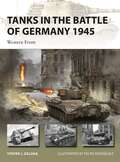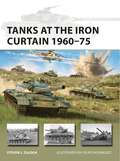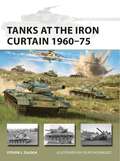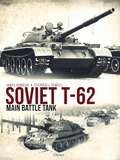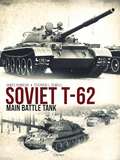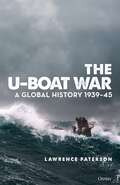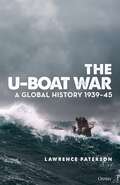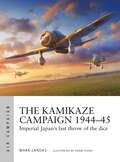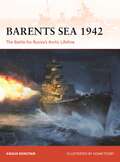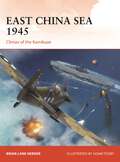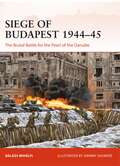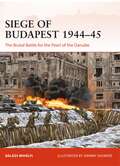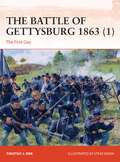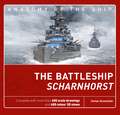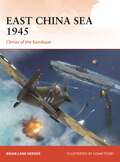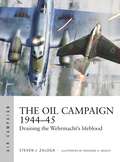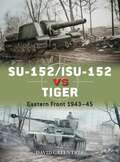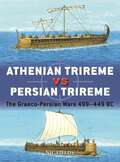- Table View
- List View
The Ancient Assyrians: Empire and Army, 883–612 BC
by Mark HealyDrawing on 30 years of scholarship, this is a unique, richly illustrated history of the Ancient Assyrian Army and Empire. For the greater part of the period from the end of the 10th century to the 7th century BC, the Ancient Near East was dominated by the dynamic military power of Assyria. This book examines the empire that is now acknowledged as the first 'world' empire, and thus progenitor of all others. Fully illustrated in colour throughout, with photographs of artefacts, drawings and maps, it focuses on the Assyrian Army, the instrument that secured such immense conquests, now regarded by historians as being the most effective of pre-classical times. It was not only responsible for the creation of history's first independent cavalry arm, but also for the development of siege weapons later used by both Greece and Rome. There is a great deal of visual evidence showing how this army evolved over three centuries. During the rediscovery and excavation of the Assyrian civilisation in the mid-19th century, many wall reliefs and artefacts were recovered, and the enormous amount of research carried out by Assyriologists since that time has revealed the immense impact of the Assyrian Empire on history. Such has been the scale of archaeological discovery in more recent years that it is now possible to give the actual names of chariot/cavalry unit commanders. Drawing on this rich scholarship, and utilising the fantastic collections of museums around the world, Mark Healy presents a unique new history of this fascinating army and empire.
Tanks in the Battle of Germany 1945: Western Front (New Vanguard)
by Steven J. ZalogaThe crossing of the river Rhine marked the beginning of the end of the Third Reich, but the Wehrmacht would fight ferociously on its home soil until the fall of Berlin. The Battle of Germany saw the most advanced tanks of the Allies pitted against the remnants of the once-formidable Panzerwaffe, now exhausted and lacking many of the essentials of armored warfare, but equipped with the biggest and most powerful tanks they would ever field. In these last months the Allies were now equipped with the most advanced Shermans such as the M4A3E8, as well as some of the types that would go on to have successful postwar careers such as the Pershing, Comet, and Chaffee. In contrast the Panzer forces had pinned their hopes on small numbers of monstrous types such as the Jagdtiger and Tiger II, as well as the workhorse Sturmgeschütz and Panzer IVs and Vs. But with German forces crumbling, the Panzerwaffe lacked trained crews, replacement vehicles and fuel, while the Allies' well-supported tank forces advanced through Germany in spectacular combined-arms fashion. Packed with information on tank numbers, types, and comparative performance, this book sheds new light on the two sides' tanks, organization, and doctrine, and explains how the ultimate tank battles of World War II were really fought.
Tanks at the Iron Curtain 1960–75 (New Vanguard)
by Steven J. ZalogaA new analysis of the technology and tanks that faced off against each other on opposite sides of the Iron Curtain, during the very height of the Cold War.From the 1960s onwards, there was a generational shift in tank design and warfare with the advent of CBR (chemical, biological, radiological) protection and a move away from HEAT ammunition to APFSDS. This shift confronted the growing threat of guided anti-tank missiles and saw the introduction of composite armor. Soviet heavy tanks and tank destroyer/assault guns became obsolete, giving way to the technological might of the T-62 and T-64, while NATO forces employed the Chieftain, AMX-30, Leopard I, and M60, plus the initial attempt at a common US-German tank, the MBT-70. Using detailed illustrations and contemporary photographs, this companion volume to NVG 301, Tanks at the Iron Curtain 1946–60 focuses on key battle tanks and their technology to give a comprehensive overall picture of how tanks developed during modern times.
Tanks at the Iron Curtain 1960–75 (New Vanguard)
by Steven J. ZalogaA new analysis of the technology and tanks that faced off against each other on opposite sides of the Iron Curtain, during the very height of the Cold War.From the 1960s onwards, there was a generational shift in tank design and warfare with the advent of CBR (chemical, biological, radiological) protection and a move away from HEAT ammunition to APFSDS. This shift confronted the growing threat of guided anti-tank missiles and saw the introduction of composite armor. Soviet heavy tanks and tank destroyer/assault guns became obsolete, giving way to the technological might of the T-62 and T-64, while NATO forces employed the Chieftain, AMX-30, Leopard I, and M60, plus the initial attempt at a common US-German tank, the MBT-70. Using detailed illustrations and contemporary photographs, this companion volume to NVG 301, Tanks at the Iron Curtain 1946–60 focuses on key battle tanks and their technology to give a comprehensive overall picture of how tanks developed during modern times.
Soviet T-62 Main Battle Tank
by James Kinnear Stephen SewellThe T-62 is one of the most widespread tanks used by the Soviets during the Cold War. Developed from the T-55, the T-62 enjoyed a long career in the Red Army and even into the early days of the reformed Russian Army. It was the principal tank used by Soviet forces in the Soviet-Afghan War, and went on to see service with Russian forces in Chechnya and South Ossetia. It has also been employed in almost every conflict in the Middle East and Africa from its introduction into service. It remains in service with many countries throughout the world and has seen a great deal of use in the Syrian Civil War. Containing more than 400 stunning contemporary and modern photographs, and written by two experts on Soviet armour, this authoritative book tells the complete story of the T-62.
Soviet T-62 Main Battle Tank
by James Kinnear Stephen SewellThe T-62 is one of the most widespread tanks used by the Soviets during the Cold War. Developed from the T-55, the T-62 enjoyed a long career in the Red Army and even into the early days of the reformed Russian Army. It was the principal tank used by Soviet forces in the Soviet-Afghan War, and went on to see service with Russian forces in Chechnya and South Ossetia. It has also been employed in almost every conflict in the Middle East and Africa from its introduction into service. It remains in service with many countries throughout the world and has seen a great deal of use in the Syrian Civil War. Containing more than 400 stunning contemporary and modern photographs, and written by two experts on Soviet armour, this authoritative book tells the complete story of the T-62.
The U-Boat War: A Global History 1939–45
by Lawrence PatersonThe accepted historical narrative of the Second World War predominantly assigns U-boats to the so-called 'Battle of the Atlantic', almost as if the struggle over convoys between the new world and the old can be viewed in isolation from simultaneous events on land and in the air. This has become an almost accepted error. The U-boats war did not exist solely between 1940 and 1943, nor did the Atlantic battle occur in seclusion from other theatres of action. The story of Germany's second U-boat war began on the first day of hostilities with Britain and France and ended with the final torpedo sinking on 7 May 1945. U-boats were active in nearly every theatre of operation in which the Wehrmacht served, and within all but the Southern Ocean. Moreover, these deployments were not undertaken in isolation from one another; instead they were frequently interconnected in what became an increasingly inefficient German naval strategy. This fascinating new book places each theatre of action in which U-boats were deployed into the broader context of the Second World War in its entirety while also studying the interdependence of the various geographic deployments. It illustrates the U-boats' often direct relationship with land, sea and aerial campaigns of both the Allied and Axis powers, dispels certain accepted mythologies, and reveals how the ultimate failure of the U-boats stemmed as much from chaotic German military and industrial mismanagement as it did from Allied advances in code-breaking and weaponry.
The U-Boat War: A Global History 1939–45
by Lawrence PatersonThe accepted historical narrative of the Second World War predominantly assigns U-boats to the so-called 'Battle of the Atlantic', almost as if the struggle over convoys between the new world and the old can be viewed in isolation from simultaneous events on land and in the air. This has become an almost accepted error. The U-boats war did not exist solely between 1940 and 1943, nor did the Atlantic battle occur in seclusion from other theatres of action. The story of Germany's second U-boat war began on the first day of hostilities with Britain and France and ended with the final torpedo sinking on 7 May 1945. U-boats were active in nearly every theatre of operation in which the Wehrmacht served, and within all but the Southern Ocean. Moreover, these deployments were not undertaken in isolation from one another; instead they were frequently interconnected in what became an increasingly inefficient German naval strategy. This fascinating new book places each theatre of action in which U-boats were deployed into the broader context of the Second World War in its entirety while also studying the interdependence of the various geographic deployments. It illustrates the U-boats' often direct relationship with land, sea and aerial campaigns of both the Allied and Axis powers, dispels certain accepted mythologies, and reveals how the ultimate failure of the U-boats stemmed as much from chaotic German military and industrial mismanagement as it did from Allied advances in code-breaking and weaponry.
The Kamikaze Campaign 1944–45: Imperial Japan's last throw of the dice (Air Campaign)
by Mark LardasAn illustrated history of how Japan devised and launched a new kind of air campaign in late 1944 – the suicidal assaults of the kamikaze units against the approaching Allied fleets.As summer changed to autumn in 1944, Japan was losing the war. Still unwilling to surrender, Japan's last hope was to try to wear down US resolve enough to reach a negotiated settlement. Extraordinary measures seemed necessary, and the most extraordinary was the formation of Special Attack Units – known to the Allies as the kamikazes. The concept of organized suicide squadrons was first raised on June 15, 1944. By August, formations were being trained. These formations were first used in the October 1944 US invasion of the Philippine Islands, where they offered some tactical success. The program was expanded into a major campaign over the rest of the Pacific War, seeing a crescendo during the struggle for Okinawa in April through May 1945. This highly illustrated history examines not just the horrific missions themselves, but the decisions behind the kamikaze campaign, how it developed, and how it became a key part of Japanese strategy. Although the attacks started on an almost ad hoc basis, the kamikaze soon became a major Japanese policy. By the end of the war, Japan was manufacturing aircraft specifically for kamikaze missions, including a rocket-powered manned missile. A plan for a massive use of kamikazes to defend the Japanese Home Islands from invasion was developed, but never executed because of Japan's surrender in August 1945. Packed with diagrams, maps and 3D reconstructions of the attacks, this book also assesses the Allied mitigation techniques and strategies and the reasons and the degree to which they were successful.
The Kamikaze Campaign 1944–45: Imperial Japan's last throw of the dice (Air Campaign)
by Mark LardasAn illustrated history of how Japan devised and launched a new kind of air campaign in late 1944 – the suicidal assaults of the kamikaze units against the approaching Allied fleets.As summer changed to autumn in 1944, Japan was losing the war. Still unwilling to surrender, Japan's last hope was to try to wear down US resolve enough to reach a negotiated settlement. Extraordinary measures seemed necessary, and the most extraordinary was the formation of Special Attack Units – known to the Allies as the kamikazes. The concept of organized suicide squadrons was first raised on June 15, 1944. By August, formations were being trained. These formations were first used in the October 1944 US invasion of the Philippine Islands, where they offered some tactical success. The program was expanded into a major campaign over the rest of the Pacific War, seeing a crescendo during the struggle for Okinawa in April through May 1945. This highly illustrated history examines not just the horrific missions themselves, but the decisions behind the kamikaze campaign, how it developed, and how it became a key part of Japanese strategy. Although the attacks started on an almost ad hoc basis, the kamikaze soon became a major Japanese policy. By the end of the war, Japan was manufacturing aircraft specifically for kamikaze missions, including a rocket-powered manned missile. A plan for a massive use of kamikazes to defend the Japanese Home Islands from invasion was developed, but never executed because of Japan's surrender in August 1945. Packed with diagrams, maps and 3D reconstructions of the attacks, this book also assesses the Allied mitigation techniques and strategies and the reasons and the degree to which they were successful.
Barents Sea 1942: The Battle for Russia’s Arctic Lifeline (Campaign)
by Angus KonstamA gripping examination of the Battle of the Barents Sea, fought in the near darkness and icy cold of the northern winter, in which the Kriegsmarine sought to sever the crucial Allied Arctic Convoy route once and for all.The Arctic convoys that passed through the cold, dangerous waters of the Barents Sea formed a vital lifeline – a strategic link in tanks, supplies and above all goodwill between the Western Allies and the Soviet Union. In December 1942, under Operation Regenbogen (Rainbow), the German Kriegsmarine sought to strike a crippling blow on the Arctic convoys and finally sever this all-important sea route. In this fascinating work, renowned naval expert Angus Konstam documents the fate of the Allied Convoy JW 51B as it came under attack from some of the Kriegsmarine's most powerful surface warships – a pocket battleship, a heavy cruiser and six destroyers. Illustrated with stunning battlescene artworks, maps, 3D diagrams and photographs, it explores the David and Goliath struggle between the Allied ships defending the convoy and the powerful German force, until the arrival of the two British cruisers tipped the balance of power. The Battle of the Barents Sea, fought amid snowstorms and the darkness of the Arctic night, would prove to be a turning point in the hard-fought war in northern waters, and would test Hitler's patience with his surface fleet to the limit.
Barents Sea 1942: The Battle for Russia’s Arctic Lifeline (Campaign)
by Angus KonstamA gripping examination of the Battle of the Barents Sea, fought in the near darkness and icy cold of the northern winter, in which the Kriegsmarine sought to sever the crucial Allied Arctic Convoy route once and for all.The Arctic convoys that passed through the cold, dangerous waters of the Barents Sea formed a vital lifeline – a strategic link in tanks, supplies and above all goodwill between the Western Allies and the Soviet Union. In December 1942, under Operation Regenbogen (Rainbow), the German Kriegsmarine sought to strike a crippling blow on the Arctic convoys and finally sever this all-important sea route. In this fascinating work, renowned naval expert Angus Konstam documents the fate of the Allied Convoy JW 51B as it came under attack from some of the Kriegsmarine's most powerful surface warships – a pocket battleship, a heavy cruiser and six destroyers. Illustrated with stunning battlescene artworks, maps, 3D diagrams and photographs, it explores the David and Goliath struggle between the Allied ships defending the convoy and the powerful German force, until the arrival of the two British cruisers tipped the balance of power. The Battle of the Barents Sea, fought amid snowstorms and the darkness of the Arctic night, would prove to be a turning point in the hard-fought war in northern waters, and would test Hitler's patience with his surface fleet to the limit.
East China Sea 1945: Climax of the Kamikaze (Campaign)
by Brian Lane HerderThis study describes the air-sea offensive supporting the ground-force invasions of Iwo Jima and Okinawa in February and April 1945, which led to the sinking of the Yamato and the onslaught of the Japanese kamikaze.During the Pacific War, the island invasions of Iwo Jima and Okinawa were the last two major ground campaigns. By the time these took place in early 1945, the US Navy had reached an exceptional level of coordination in its amphibious operations, and was able to overrun and subdue Japanese territories efficiently. Faced with the increasing might of these forces and to prevent further defeat, Imperial Japan deployed its kamikaze aircraft and attacked many US heavy aircraft carriers and destroyers; several were sunk, while others were knocked out of the war. This superbly illustrated book explores the air–sea aspects of the pivotal battles that took place, and includes the “death ride” of the Japanese battleship Yamato (the largest ever built), and the mass kamikaze attacks off Iwo Jima and Okinawa, as well as the Iwo Jima and Okinawa amphibious invasions and the naval and air bombardments of the two islands. It also considers the contribution of the USAAF and the British Pacific Fleet to the eventual victory of US air and ground forces.
Siege of Budapest 1944–45: The Brutal Battle for the Pearl of the Danube (Campaign)
by Balázs MihályiA gripping and detailed study of the brutal urban battle for Budapest, which saw German and Hungarian troops struggling to halt the joint Soviet-Romanian offensive to take the key city on the Danube.The 52-day-long siege of Budapest witnessed some of the most destructive urban fighting of the war. The Transdanubia region was strategically vital to Nazi Germany for its raw materials and industry, and because of the bridgehead it allowed into Austria. As a result, Hitler declared Budapest a fortress city in early December 1944. The battle for the city pitted 90,000 German and Hungarian troops against 170,000 Soviet (2nd and 3rd Ukrainian Fronts) and Romanian attackers. The operations to take the city ran across several phases, from the initial Soviet approach to Budapest commencing in late October 1944, through the encirclement of city first on the Pest side of the Danube, and then on the Buda bank, and on to the savage urban fighting that began in December 1944 for the Hungarian capital. This superbly detailed work analyses the background, chronology and consequences of the siege from both a military and political perspective, and documents the huge losses in military and civilian casualties and material damage.
Siege of Budapest 1944–45: The Brutal Battle for the Pearl of the Danube (Campaign)
by Balázs MihályiA gripping and detailed study of the brutal urban battle for Budapest, which saw German and Hungarian troops struggling to halt the joint Soviet-Romanian offensive to take the key city on the Danube.The 52-day-long siege of Budapest witnessed some of the most destructive urban fighting of the war. The Transdanubia region was strategically vital to Nazi Germany for its raw materials and industry, and because of the bridgehead it allowed into Austria. As a result, Hitler declared Budapest a fortress city in early December 1944. The battle for the city pitted 90,000 German and Hungarian troops against 170,000 Soviet (2nd and 3rd Ukrainian Fronts) and Romanian attackers. The operations to take the city ran across several phases, from the initial Soviet approach to Budapest commencing in late October 1944, through the encirclement of city first on the Pest side of the Danube, and then on the Buda bank, and on to the savage urban fighting that began in December 1944 for the Hungarian capital. This superbly detailed work analyses the background, chronology and consequences of the siege from both a military and political perspective, and documents the huge losses in military and civilian casualties and material damage.
The Battle of Gettysburg 1863: The First Day (Campaign)
by Timothy J. OrrThis first volume of three discusses the tactical decisions made on day one and the ensuing combat, while also including a brief summary of the grand strategy in the Eastern Theater of the war, the conduct of the Pennsylvania Campaign from June 6 to 30, 1863, and the plight of civilians caught up in the conflict.The Battle of Gettysburg, which took place July 1–3, 1863 in and around the town of Gettysburg, PA resulted in the largest number of casualties of the entire American Civil War and is seen as the key turning point in the conflict. On its first day, Confederate General Robert E. Lee's Army of Northern Virginia sought to destroy the Union army, forcing its men to retreat through the streets of the Pennsylvania town to the hills just to the south. This volume, the first of three to cover the battle in depth, includes the morning cavalry skirmish, the morning clash at the Herbst's Woodlot and at the railroad cut, the afternoon clash at Oak Ridge, the afternoon fight at the Edward McPherson farm, the afternoon rout of the 11th Corps, the last stand of the 1st Corps at Seminary Ridge, the Union retreat through town, and the positions of the armies at nightfall.
The Battleship Scharnhorst (Anatomy of The Ship)
by Stefan DraminskiThe Kriegsmarine's Scharnhorst was a German capital ship, described either as a battleship or battlecruiser, and the lead ship of her class, which included one other ship, Gneisenau. She was launched on 3 October 1936 and completed in January 1939, armed with nine 28cm C/34 guns in three triple turrets. She operated with Gneisenau for much of the early portion of World War II, including sorties into the Atlantic to raid British merchant shipping. They took part in Operation Weserübung (April–June 1940), the German invasion of Norway, during which they sank the aircraft carrier HMS Glorious and her escort destroyers Acasta and Ardent. Scharnhorst also sank HMS Rawalpindi in November 1939. In early 1943, Scharnhorst joined the Tirpitz in Norway to intercept Allied convoys to the Soviet Union. On a sortie from Norway to attack a convoy, the German force was intercepted by British ships and during the Battle of the North Cape (26 December 1943), HMS Duke of York and her escorts sank Scharnhorst. Most of her crew was lost. This is the most comprehensive examination of Scharnhorst ever published, drawing on new research and technology to tell the full story of the ship. It includes a complete set of detailed line drawings with fully descriptive keys and full-colour 3D artwork, supported by technical details, photographs, and text on the building of the ship, as well as a record of her service history.
East China Sea 1945: Climax of the Kamikaze (Campaign)
by Brian Lane HerderThis study describes the air-sea offensive supporting the ground-force invasions of Iwo Jima and Okinawa in February and April 1945, which led to the sinking of the Yamato and the onslaught of the Japanese kamikaze.During the Pacific War, the island invasions of Iwo Jima and Okinawa were the last two major ground campaigns. By the time these took place in early 1945, the US Navy had reached an exceptional level of coordination in its amphibious operations, and was able to overrun and subdue Japanese territories efficiently. Faced with the increasing might of these forces and to prevent further defeat, Imperial Japan deployed its kamikaze aircraft and attacked many US heavy aircraft carriers and destroyers; several were sunk, while others were knocked out of the war. This superbly illustrated book explores the air–sea aspects of the pivotal battles that took place, and includes the “death ride” of the Japanese battleship Yamato (the largest ever built), and the mass kamikaze attacks off Iwo Jima and Okinawa, as well as the Iwo Jima and Okinawa amphibious invasions and the naval and air bombardments of the two islands. It also considers the contribution of the USAAF and the British Pacific Fleet to the eventual victory of US air and ground forces.
World War II Fighter Planes Spotter's Guide
by Tony HolmesWorld War II saw pilots from around the world battling in the skies over Europe, Asia and Africa, with victory resting upon their nerve, skill and the capabilities of some of history's most iconic aircraft. In the chaos of battle, it was vital that they could quickly identify friend from foe. But do you know your Hurricane from your Bf 109, or what the legendary P-51 Mustang looks like? Do you know the wingspan of the A6M Zero-sen, or how fast it could fly?THE WORLD WAR II FIGHTER PLANES SPOTTER'S GUIDE answers all of these questions and more, providing essential information on over 90 legendary aircraft, from the celebrated Spitfire to the jet-powered Me 262. Featuring full-colour artwork to aid recognition, as well as all the details you need to assess their performance, this is the perfect pocket guide to the Allied and Axis fighters of World War II
World War II Fighter Planes Spotter's Guide
by Tony HolmesWorld War II saw pilots from around the world battling in the skies over Europe, Asia and Africa, with victory resting upon their nerve, skill and the capabilities of some of history's most iconic aircraft. In the chaos of battle, it was vital that they could quickly identify friend from foe. But do you know your Hurricane from your Bf 109, or what the legendary P-51 Mustang looks like? Do you know the wingspan of the A6M Zero-sen, or how fast it could fly?THE WORLD WAR II FIGHTER PLANES SPOTTER'S GUIDE answers all of these questions and more, providing essential information on over 90 legendary aircraft, from the celebrated Spitfire to the jet-powered Me 262. Featuring full-colour artwork to aid recognition, as well as all the details you need to assess their performance, this is the perfect pocket guide to the Allied and Axis fighters of World War II
The Oil Campaign 1944–45: Draining the Wehrmacht's lifeblood (Air Campaign)
by Steven J. ZalogaA new illustrated history of one of the key air campaigns of late World War II – the American effort to cripple Germany's oil production, and grind its armed forces to a halt.With retreating German forces losing their oilfields on the Eastern Front, Germany was reliant on its own facilities, particularly for producing synthetic oil from coal. However, these were within range of the increasingly mighty Allied air forces. In 1944 the head of the US Strategic Air Forces, General Carl Spaatz was intent on a new campaign that aimed to cripple the German war machine by depriving it of fuel. The USAAF's Oil Campaign built up momentum during the summer of 1944 and targeted these refineries and plants with its daylight heavy bombers. Decrypted German communications made it clear that the Oil Campaign was having an effect against the Wehrmacht. Fuel shortages in the autumn of 1944 forced the Luftwaffe to ground most of its combat units except for fighters involved in the defense of the Reich. Fuel shortages also forced the Kriegsmarine to place most of its warships in harbor except for the U-boats and greatly hampered German army campaigns such as the Battle of the Bulge in December 1944–45. This fascinating book packed with key photos and illustrations examines the controversies and debates over the focus of the US bombing campaign in the final year of the war, and the impact it had on the war effort overall.
The Oil Campaign 1944–45: Draining the Wehrmacht's lifeblood (Air Campaign)
by Steven J. ZalogaA new illustrated history of one of the key air campaigns of late World War II – the American effort to cripple Germany's oil production, and grind its armed forces to a halt.With retreating German forces losing their oilfields on the Eastern Front, Germany was reliant on its own facilities, particularly for producing synthetic oil from coal. However, these were within range of the increasingly mighty Allied air forces. In 1944 the head of the US Strategic Air Forces, General Carl Spaatz was intent on a new campaign that aimed to cripple the German war machine by depriving it of fuel. The USAAF's Oil Campaign built up momentum during the summer of 1944 and targeted these refineries and plants with its daylight heavy bombers. Decrypted German communications made it clear that the Oil Campaign was having an effect against the Wehrmacht. Fuel shortages in the autumn of 1944 forced the Luftwaffe to ground most of its combat units except for fighters involved in the defense of the Reich. Fuel shortages also forced the Kriegsmarine to place most of its warships in harbor except for the U-boats and greatly hampered German army campaigns such as the Battle of the Bulge in December 1944–45. This fascinating book packed with key photos and illustrations examines the controversies and debates over the focus of the US bombing campaign in the final year of the war, and the impact it had on the war effort overall.
SU-152/ISU-152 vs Tiger: Eastern Front 1943–45 (Duel)
by David GreentreeThis fully illustrated volume compares two of the most iconic AFV's: the SU-152/ISU-152 and the Tiger, used on the Eastern Front during World War II.On the Eastern Front in 1943, the Tiger-equipped heavy Panzer battalions gave German armoured divisions an unmatched capability that cost the Red Army dearly. The Tiger's 88mm gun had the potential to carve through Soviet defences in the attack and cause havoc amongst advancing Soviet armoured formations when used in defence. Neither of the Red Army's heavy tanks (the KV-1 and KV-2) could match the Tiger's gun, and, more importantly, penetrate its armour at anything approaching standard combat range. The Soviet response was a stopgap Tiger-killing vehicle that mounted a 152mm artillery piece onto the KV tank's chassis: the SU-152. The latter would evolve into the ISU-152 in late 1943 (mounting the same powerful gun on an IS chassis). This fascinating book describes the mighty duels fought between these opposing AFVs. The colour illustrations explore key details of both the SU-152/ISU-152 and Eastern Front Tigers, including armament, ammunition and crew positions, and the period photographs show rarely seen views of these iconic AFVs in action. How each attempted to best the other using its strengths and advantages is documented across a wide range of dramatic Eastern Front armoured battles.
Athenian Trireme vs Persian Trireme: The Graeco-Persian Wars 499–449 BC (Duel)
by Nic FieldsA fascinating and detailed exploration of one of the most famous warships of the Ancient world - the trireme - and its tactical employment by the opposing sides in the 5th-century BC Graeco-Persian Wars.You may be familiar with the Athenian trireme – but how much do you know about the ram-armed, triple-oared warships that it dueled against at the battles of Artemision, Salamis and the Eurymedon River? How similar or different were these warships to each other? And why did the Persians rely on Phoenician vessels to form much of their navy? Much attention has been devoted to the Greek trireme, made famous by modern reconstruction – with only passing notice given to the opposing Persian navy's vessels in illustrated treatments. Join us on the Aegean as, for the first time, we reveal a rarely attempted colour reconstruction of a trireme in Persian service. Compare the form, construction, design, manoeuvrability, and tactical deployment of the opposing triremes, aided by stunning illustrations. Man the decks of these warships with the fighting complement of Greek citizen hoplites, Scythian archers and Persian marines, and learn why the Greeks placed a bounty of 10,000 drachmae on the head of Artemisia – the Karian queen and Persian admiral, and the only woman among Xerxes' commanders.
Athenian Trireme vs Persian Trireme: The Graeco-Persian Wars 499–449 BC (Duel)
by Nic FieldsA fascinating and detailed exploration of one of the most famous warships of the Ancient world - the trireme - and its tactical employment by the opposing sides in the 5th-century BC Graeco-Persian Wars.You may be familiar with the Athenian trireme – but how much do you know about the ram-armed, triple-oared warships that it dueled against at the battles of Artemision, Salamis and the Eurymedon River? How similar or different were these warships to each other? And why did the Persians rely on Phoenician vessels to form much of their navy? Much attention has been devoted to the Greek trireme, made famous by modern reconstruction – with only passing notice given to the opposing Persian navy's vessels in illustrated treatments. Join us on the Aegean as, for the first time, we reveal a rarely attempted colour reconstruction of a trireme in Persian service. Compare the form, construction, design, manoeuvrability, and tactical deployment of the opposing triremes, aided by stunning illustrations. Man the decks of these warships with the fighting complement of Greek citizen hoplites, Scythian archers and Persian marines, and learn why the Greeks placed a bounty of 10,000 drachmae on the head of Artemisia – the Karian queen and Persian admiral, and the only woman among Xerxes' commanders.

